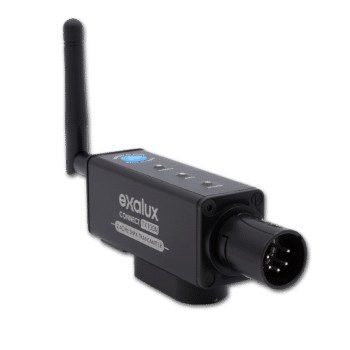EXALUX™ CONNECT TX100N is an ultra compact wireless DMX transmitter that can be used in the studios or on location.
CONNECT TX100N, in short:
CONNECT TX100N features PoD technology which enables the unit to be powered via its XLR connector. The unit is fully compliant with all LumenRadio CRMX™ receivers, such as RX100S and RX200N.
SKU : CNT.001.005
EAN code : 3760252033450
Availability : In stock

CONNECT TX100N feature unibody enclosures milled from a block of aluminium, allowing them to get a compact and stronger design.
The external antenna allows a long range, up to 500m depending on the transmitter and the environment.

CONNECT TX100N CRMX transmitter is our first PoD-PD compliant system.
PoD concept has been designed to ease powering DMX dongles (power & data in the same 5pos DMX cable). POD means less cable and a single power supply for several devices.
Thanks to its wide supply range (+5 to 24VDC), CONNECT TX100N can be powered through the USB connector of a DMX fixture, a Vlock battery via the D-TAP connector or any external PSU.

CONNECT TX100N unit can be mounted on industry-standard AV/Cinema clamps, tripods and arms thanks to the 3/8 UNC adapter.
It’s easy, simple and it will save you time!

The connect TX100N‘s antenna is removable, meaning you can replace it by a different model to better suit your needs.

Based on LumenRadio CRMX™ technology, EXALUX™ CONNECT RX200N brings DMX fidelity without any latency.



| Power Connection | 2.0x5.5MM DC jack |
| Interface | Unlink (switch), Power, Paired, |
| DMX Status(LED) | |
| Power Consumption | 1.5W |
| Housing / Mounting | Aluminum / M10 |
| IP Rating | IP30 |
| Certifications | CE, RoHS |
| Weight | 185g |
| Input Voltage | Min : 4.5VDC | Typ : 5VDC | Max : 26VDC |
| Storage T° | Min : -20°C | Typ : 25°C | Max : +75°C |
| Operating T° | Min : -10°C | Typ : 25°C | Max : +55°C |
| Standard / Technology | LumenRadio CRMX™ |
| Frequency | 2.402 ~ 2.480 GHz |
| Antenna | Omnidirectional, |
| 2.4GHZ 2.0dBi, SMA | |
| RF Output | 20 dBm (100mW) |
| RF Modulation | GFSK |
| Range | 500-1000m |
| (depending on the environment) |
| Protocol | DMX512-A |
| Universe support | 1 |
| DMX frame rate | 0,8-830Hz |
| End to end latency | < 5ms |
| DMX Input | Neutrik XLR 5 pins Female |


PoD concept has been designed to ease powering DMX dongles (power & data in the same 5pos DMX cable), concept and terminology inspired by Ethernet PoE – Power-over Ethernet.
CONNECT+ is the a PoD-PSE compliant system (Power Sourcing Equipment), while TX100N CRMX transmitter is our first PoD-PD compliant system (Powered Equipement).
DMX XLR5 pin 5 (PoD 5V) is used to carry +5VDC power supply, 500mA max (USB standard). DMX XLR5 pin 4 (PoD Detect) is used to monitor and detect PoD systems.
For security reasons, the PoD 5V output (on PoD-PSE devices) on each DMX XLR5 (pin 5) is controlled by a power switch with limitation and protection features (V, I, T°), and the voltage is constantly monitored (PoD Detect).
When comparing the radio CRMX emitter/receiver dongles available on the market, user should consider the following :
An XLR5 connector embedded into the dongle case provides a more compact and reliable solution than a cable-based XLR connection.
CRMX radio range is related to the antenna, wether it is internal or external, the latter being more efficient than the former, especially in a radio disturbed environment.
A device with an embedded battery will provide a more compact solution, but it will need to be recharged after a few hours. A device without internal battery will require an external cable (if not powered direclty form DMX) and it can be powered by an external battery with large capacity and extended life, or by an external power supply, sometimes over a wider power supply voltage,
Actually, this all depends on the way you want to build and use your lighting control system and equipments.
CRMX by LumenRadio™ patented Cognitive Coexistence technology allows our wireless solutions to ensure optimum performance even when other wireless systems are operating in the same area.
This achievement is possible because CRMX is based on the Frequency Hoping Spread Spectrum (FHSS) technology.